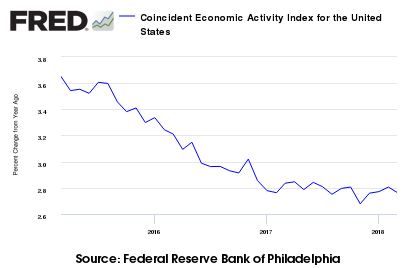
The year-over-year rate of growth relative to the previous month of the US Coincident Index was down. A comparison of this US Coincident Index to other coincident indices follows.
Analyst Opinion of the Current Status of the Coincident Indicators
The reality is that most of the economic indicators have moderate to significant backward revision – and this month most are showing moderate and stable growth. Out of this group of coincident indicators discussed in this post, only ECRI and the Aruoba-Diebold-Scotti business conditions index have no backward revision – and both have a good track record of seeing the economy accurately in almost real time.
Economic indicators that coincide with economic movements are coincident indicators. Coincident indicators by definition do not provide a forward economic view. However, trends are valid until they are no longer valid, making the trend lines on the coincident indicators a forward forecasting tool.
Excerpt from Philly Fed Report for the United States Coincident Index
The Federal Reserve Bank of Philadelphia has released the coincident indexes for the 50 states for September 2017. Over the past three months, the indexes increased in 37 states and decreased in 13, for a three-month diffusion index of 48. In the past month, the indexes increased in 38 states, decreased in 10, and remained stable in two, for a one-month diffusion index of 56. For comparison purposes, the Philadelphia Fed has also developed a similar coincident index for the entire United States. The Philadelphia Fed’s U.S. index rose 0.6 percent over the past three months and 0.2 percent in September.
z philly coincident.PNG
In the graph below, the blue line shows the year-over-year growth rate of the US Concident Index, while the red line shows the month-over-month change. The year-over-year trend is down.














Leave A Comment